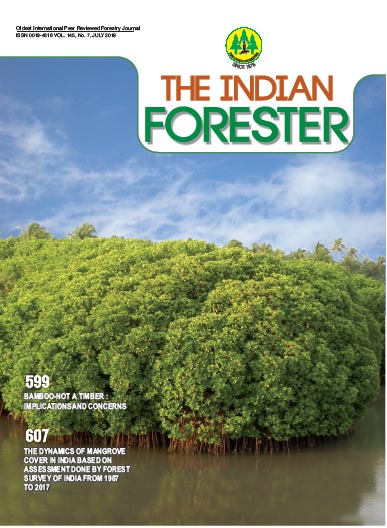Effect of Tree Leaf Mulches on Weed In Pearl Millet + Mung Bean Intercropping under Guava Based Agri-Horti System
DOI:
https://doi.org/10.36808/if/2019/v145i7/147020Keywords:
Guava Based Agro Forestry, Pearl Millet, Mung Bean, Tree Leaves Mulching, Weed Density and Dry Weight, Pearl Millet Equivalent Yield.Abstract
An experiment was laid out during rainy (Kharif) in Randomized Block Design with three replications under agri-horti system (fruit based agro forestry system) viz., guava based Agri-horti system. The soil of the experimental field was sandy loam in texture with acidic in reaction. It was moderately fertile, being low in organic carbon and nitrogen, medium in phosphorus and potassium. Pearl millet + Mung bean + Mulching (Moringa Spp. leaves - 4 ton/ha) recorded the lowest weed density and weed dry weight thereby maximum weed control efficiency which proved superiority over other mulching treatments. Pearl millet + Mung bean intercropping along with mulching of Moringa spp. Leaves (4 ton/ha) recorded significantly more total pearl millet equivalent grain and straw yields over other treatment combinations.References
Bilalis D., Sidiras N., Economou G. and Vakali C. (2003). Effect of Different Levels of Wheat Straw Soil Surface Coverage on Weed Flora in Vicia faba Crops. Agron. Crop Sciences, 189: 233-241.
Bueren E.T.L., Struik P.C. and Jacobsen E. (2002). Ecological concepts in organic farming and their consequences for anorganic crop ideotype. J. of Life Science, 50: 1-26.
Duryea M.L., English R.J. and Hermansen L.A. (1999). A comparison of landscape mulches: chemical, allelopathic, and decomposition properties. J. of Arboriculture, 25: 88-97.
Haque M., Sharma R.P. and Prasad S. (2008). Weed control in maize based intercropping system under rainfed condition. ISWS Biennial Conference on Weed Management in Modern Agriculture, February 27-28, 2008, Pusa, Bihar. 118p.
Hussein H.F. and Radwan S.M.A. (2002). Bioorganic fertilization of potato under plastic mulches in relation to quality of production and associated weeds. Arab University Journal of Agricultural Sciences, Ain Shams Univ. Cairo (Egypt), 10: 287-309.
Musa M., Chawdhury G.A., Khalid A.H., Shahzad M.A. and Cheema N.M. (1996). Weed competition studies in mungbean. Absts. 5th. Pakistan Weed Science Conference, March 3-5.
Ram K. and Meena R.S. (2014). Evaluation of pearlmillet and mungbean intercropping systems in arid region of Rajasthan (India). Bangladesh J. Botany, 43(3): 367-370.
Shivran R.K. and Rana K.S. (2003). Growth and yield of maize (Zea mays L.) was influenced by cropping system and moisture conservation practices under rainfed conditions. Annals Agricultural Research, 24 (2): 350-353.
Downloads
Downloads
Published
How to Cite
Issue
Section
License
Unless otherwise stated, copyright or similar rights in all materials presented on the site, including graphical images, are owned by Indian Forester.





